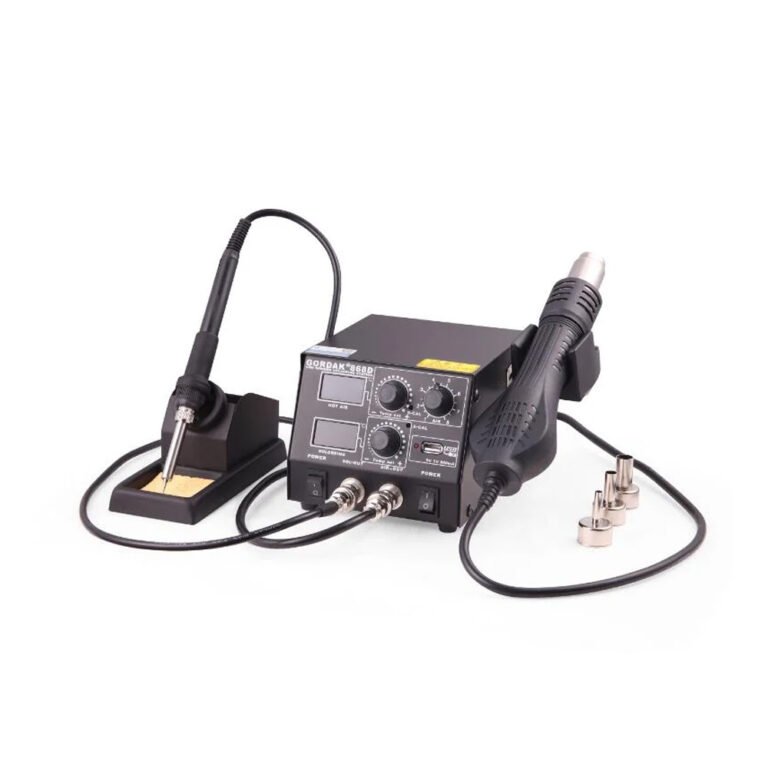When choosing a hot air rework station for soldering, desoldering, or surface-mount component repair, one of the first decisions to make is whether to go with an analog or a digital model. Both types serve the same core function—precise, controlled heating for electronic components—but they differ significantly in terms of control method, accuracy, and user experience.
At Gordak Electric, we offer both analog and digital hot air rework solutions to meet the varying needs of professionals, educators, and electronics repair technicians. This guide outlines the key differences between analog and digital rework stations to help you make an informed decision.
What Is an Analog Hot Air Rework Station?
Analog hot air rework stations use physical knobs or dials to control the temperature and airflow. These settings are typically indicated on simple printed scales, and adjustments are based on user estimation or prior experience.
Advantages of Analog Rework Stations
- Simple and intuitive to operate
- Cost-effective and ideal for basic repair tasks
- Fewer internal electronics, which can mean easier long-term maintenance
- Quick setup without complicated configurations
Limitations
- Lower precision without digital feedback
- No real-time temperature display
- Less suitable for repeatable, high-accuracy processes
What Is a Digital Hot Air Rework Station?
Digital hot air rework stations use electronic controls, often with LED or LCD displays, to manage and show temperature and airflow levels in real time. This allows for greater control, precision, and consistency.
Advantages of Digital Rework Stations
- Highly accurate temperature and airflow settings
- Real-time display for better monitoring and repeatability
- Enhanced safety features, such as automatic cooling and fault detection
- Suitable for sensitive components and advanced rework tasks
Limitations
- Higher cost compared to analog models
- Slightly more complex interface, which may require brief learning
- Maintenance may involve digital components such as sensors or control boards

Comparison Table: Analog vs. Digital
| Feature | Analog Hot Air Station | Digital Hot Air Station |
|---|---|---|
| Control Method | Manual knobs | Digital buttons or interface |
| Display | None | LED/LCD real-time display |
| Temperature Accuracy | Moderate | High |
| Airflow Adjustment | Manual dial | Precision control |
| Ease of Use | Very simple | Requires basic familiarity |
| Cost | Lower | Slightly higher |
| Maintenance | Basic, fewer parts | May require sensor servicing |
| Ideal User | Hobbyist, general repair use | Professionals, advanced users |
Which One Should You Choose?
Your choice depends on your needs, experience, and the complexity of the work you perform.
- Choose analog if you prefer a simple and cost-effective tool for standard soldering and rework jobs.
- Choose digital if your work requires precision, consistent results, and greater control over heat and airflow—especially when working with small-pitch SMDs or multilayer PCBs.
Why Choose Gordak Electric
At Gordak Electric, we provide reliable hot air rework solutions for electronics repair, assembly, and education. Whether you prefer analog or digital control, our rework stations are built for stable performance, ease of use, and long-term durability.
Our products support:
- Precise temperature and airflow control
- Fast heat-up and intelligent cooling
- Compatibility with various rework nozzles and tools
- OEM and ODM customization services
For product consultation, technical support, or business cooperation, please contact us:
Email: info@gordakelec.com
Hot Air Rework Stations
What Is a Hot Air Rework Station and How Does It Work?
Applications of a Hot Air Rework Station: What Can Be Soldered?
Hot Air Soldering for BGA and SMD Repair
Hot Air Rework Station vs. Infrared Rework Station: Pros and Cons
Analog vs. Digital Hot Air Rework Stations: What’s the Difference?
Using a Hot Air Rework Station for Mobile Phone Repairs
Can You Use a Hot Air Rework Station for Heat Shrink Tubing?
Hot Air Reflow Soldering: What It Is and How It Works
Hot Air Rework Station Maintenance Guide
Troubleshooting Common Hot Air Soldering Issues
Tips to Prevent PCB Damage While Using a Hot Air Rework Station
Beginner’s Guide to Using a Hot Air Rework Station Safely
How to Desolder SMD Components Using a Hot Air Rework Station



